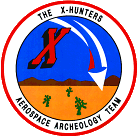
 |
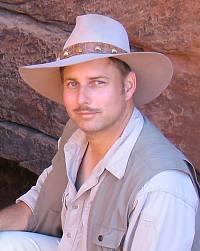 Peter W. Merlin is an aerospace historian who has been researching the history of Area 51 since 1984 and has written numerous articles on the subject. He has also appeared on such television programs as Modern Marvels, Mystery Hunters, Man-Moment-Machine, Inside Area 51, UFO: Down To Earth, Return to Area 51, Atomic Journeys, UFO Hunters, MysteryQuest, and others. As a freelance writer Merlin has published articles in a variety of periodicals, covering subjects from aerospace history to nuclear weapon accidents. He is the author of Mach 3+: NASA/USAF YF-12 Flight Research, 1969-1979 (NASA, 2001), From Archangel to Senior Crown - Design and Development of the Blackbird (American Institute of Aeronautics and Astronautics, 2008), Ikhana Unmanned Aircraft System Western States Fire Missions (NASA, 2009), "The Evolution of Remotely Piloted Research Vehicles," NASA's Contributions to Aeronautics, Vol. 2, edited by Dr. Richard P. Hallion (NASA, 2010), and X-Plane Crashes - Exploring Experimental, Rocket Plane and Spycraft Incidents, Accidents and Crash Sites, with Tony Moore (Specialty Press, 2008). He also co-authored Donald L. Mallick's autobiography, The Smell of Kerosene: A Test Pilot's Odyssey (NASA, 2003).
Peter W. Merlin is an aerospace historian who has been researching the history of Area 51 since 1984 and has written numerous articles on the subject. He has also appeared on such television programs as Modern Marvels, Mystery Hunters, Man-Moment-Machine, Inside Area 51, UFO: Down To Earth, Return to Area 51, Atomic Journeys, UFO Hunters, MysteryQuest, and others. As a freelance writer Merlin has published articles in a variety of periodicals, covering subjects from aerospace history to nuclear weapon accidents. He is the author of Mach 3+: NASA/USAF YF-12 Flight Research, 1969-1979 (NASA, 2001), From Archangel to Senior Crown - Design and Development of the Blackbird (American Institute of Aeronautics and Astronautics, 2008), Ikhana Unmanned Aircraft System Western States Fire Missions (NASA, 2009), "The Evolution of Remotely Piloted Research Vehicles," NASA's Contributions to Aeronautics, Vol. 2, edited by Dr. Richard P. Hallion (NASA, 2010), and X-Plane Crashes - Exploring Experimental, Rocket Plane and Spycraft Incidents, Accidents and Crash Sites, with Tony Moore (Specialty Press, 2008). He also co-authored Donald L. Mallick's autobiography, The Smell of Kerosene: A Test Pilot's Odyssey (NASA, 2003).
As a founding member of the X-Hunters Aerospace Archeology Team, he also specializes in recovering historic aircraft artifacts from crash sites in the southwestern United States, especially from the areas surrounding Edwards Air Force Base, California, and Groom Lake, Nevada. He has visited over 100 aircraft wrecks including the X-1A, X-2, X-15, XP-80A, XB-51, XB-70, N-9M, YB-49, U-2, A-12, YF-12A, and SR-71.
Merlin was born in Hollywood, California. He received his Bachelor of Science degree in Aeronautical Studies from Embry-Riddle Aeronautical University in Daytona Beach, Florida. Merlin is a member of the Flight Test Historical Foundation, Nevada Test Site Historical Foundation, National Atomic Museum Foundation, Nevada Aerospace Hall of Fame, and is an Associate Member of Roadrunners Internationale. He spends much of his time exploring the southwestern United States in search of ghost towns, mines, caves, prehistoric ruins and rock art, nuclear test sites, abandoned missile silos, fossils, and interesting natural features. He has also journeyed to the mountains of Baja California, Mexico, and the Tassili N'Ajjer plateau region of the central Sahara Desert in Algeria to photograph prehistoric cave paintings. Merlin occasionally lectures on aerospace history and prehistoric archeology.
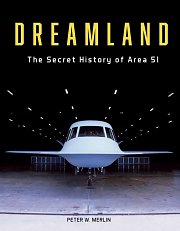 Area 51, a top-secret military installation hidden in a remote desert valley northwest of Las Vegas, Nevada, has been shrouded in mystery since 1955. Decades of government secrecy have spawned countless rumors and conspiracy theories, shrouding facts within a fog of folklore and misinformation. Such stories have captivated the public imagination and catapulted Area 51 into popular culture. Now, after more than 30 years of painstaking research, aerospace historian Peter Merlin cuts through the myths to reveal in extraordinary detail the true story of how a ramshackle, temporary, outpost was ultimately transformed into one of the nation’s premier flight-test and evaluation facilities for advanced aviation technology and high-tech weaponry.
Area 51, a top-secret military installation hidden in a remote desert valley northwest of Las Vegas, Nevada, has been shrouded in mystery since 1955. Decades of government secrecy have spawned countless rumors and conspiracy theories, shrouding facts within a fog of folklore and misinformation. Such stories have captivated the public imagination and catapulted Area 51 into popular culture. Now, after more than 30 years of painstaking research, aerospace historian Peter Merlin cuts through the myths to reveal in extraordinary detail the true story of how a ramshackle, temporary, outpost was ultimately transformed into one of the nation’s premier flight-test and evaluation facilities for advanced aviation technology and high-tech weaponry.
This compelling narrative is based on a treasure trove of declassified documents and interviews and is richly illustrated with more than 700 images, many never published before. Schiffer Books, 2023.
Hardcover, 640 pages, more than 700 images; publishing date 10/28/2023. Order this book from Amazon.com
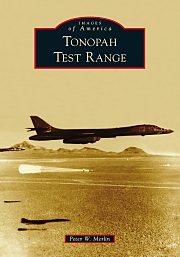 Established in 1957, Tonopah Test Range (TTR) in Nevada provided an isolated place for the Atomic Energy Commission and successor agencies to test ballistic characteristics and non-nuclear components of atomic bombs. Also known as Area 52, the vast outdoor laboratory has also been used for training exercises, testing rockets, development of electronic warfare systems and unmanned aerial vehicles, and nuclear safety experiments. During the late 1970s, the Air Force constructed an airfield for a clandestine squadron of captured Russian fighter planes that were used for tactical evaluations and to provide realistic air combat training for thousands of American airmen. The TTR airfield also served as the first operational base for the F-117A stealth fighter, an airplane designed to be virtually invisible to detection by radar.
Established in 1957, Tonopah Test Range (TTR) in Nevada provided an isolated place for the Atomic Energy Commission and successor agencies to test ballistic characteristics and non-nuclear components of atomic bombs. Also known as Area 52, the vast outdoor laboratory has also been used for training exercises, testing rockets, development of electronic warfare systems and unmanned aerial vehicles, and nuclear safety experiments. During the late 1970s, the Air Force constructed an airfield for a clandestine squadron of captured Russian fighter planes that were used for tactical evaluations and to provide realistic air combat training for thousands of American airmen. The TTR airfield also served as the first operational base for the F-117A stealth fighter, an airplane designed to be virtually invisible to detection by radar.
This book is a concise pictorial history of one of the nation's unique test facilities for Department of Defense weapons development programs. Additionally, after more than six decades of service in the national interest, TTR continues to serve a vital role in the stewardship and maintenance of America's nuclear arsenal. Arcadia Publishing, 2021.
Paperback, 128 pages, over 130 photos. Publishing date 02/22/2021. Click here to order.
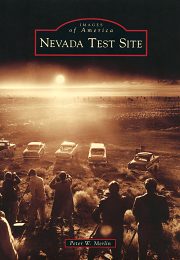 Since its establishment in 1950, the Nevada Test Site has played a vital role in the security of our nation. For four decades its primary purpose was developmental testing of nuclear explosives. Atmospheric testing at Yucca Flat and Frenchman Flat involved thousands of Army troops and Marines simulating nuclear battlefield conditions. Civil Defense planners studied blast and radiation effects, and evaluated bomb shelter designs. Testing moved underground in 1963 to eliminate radioactive fallout. Other projects at the NTS included nuclear rocket engine development for space travel, training for NASA's Apollo astronauts, excavation experiments, radioactive waste storage studies, and aircraft testing. This book is a concise pictorial history of the nation's continental nuclear proving ground, a geographically diverse testing and training complex north of Las Vegas that has evolved into a unique outdoor laboratory for government and industry research and development efforts. Arcadia Publishing, 2016.
Since its establishment in 1950, the Nevada Test Site has played a vital role in the security of our nation. For four decades its primary purpose was developmental testing of nuclear explosives. Atmospheric testing at Yucca Flat and Frenchman Flat involved thousands of Army troops and Marines simulating nuclear battlefield conditions. Civil Defense planners studied blast and radiation effects, and evaluated bomb shelter designs. Testing moved underground in 1963 to eliminate radioactive fallout. Other projects at the NTS included nuclear rocket engine development for space travel, training for NASA's Apollo astronauts, excavation experiments, radioactive waste storage studies, and aircraft testing. This book is a concise pictorial history of the nation's continental nuclear proving ground, a geographically diverse testing and training complex north of Las Vegas that has evolved into a unique outdoor laboratory for government and industry research and development efforts. Arcadia Publishing, 2016.
Paperback, 128 pages, over 130 photos. Publishing date 10/10/2016. Click here to order.
 NASA's Environmentally Responsible Aviation (ERA) project began in 2009 to explore and document the feasibility, benefits, and technical risks of advanced vehicle concepts and enabling technologies for reducing aviation's overall impact on the environment. Its goals included reducing community noise footprints, fuel burn, and nitrogen oxide emissions. This book reviews the advanced aircraft design concepts, construction technologies, and propulsion advancements that were researched by the ERA project.
NASA's Environmentally Responsible Aviation (ERA) project began in 2009 to explore and document the feasibility, benefits, and technical risks of advanced vehicle concepts and enabling technologies for reducing aviation's overall impact on the environment. Its goals included reducing community noise footprints, fuel burn, and nitrogen oxide emissions. This book reviews the advanced aircraft design concepts, construction technologies, and propulsion advancements that were researched by the ERA project.
The book is available for download in a variety of formats on the NASA Web Site or via the NASA eBooks Portal.
 This technological case study documents the design and development history of the Lockheed U-2, an airplane both famous and infamous. Proposed as a stopgap measure to provide overhead reconnaissance capability during the early years of the Cold War, the U-2 has continuously evolved to meet changing requirements into the 21st century. While many books have documented the airplane's operational history, few have made more than a cursory examination of its technical aspects, or its role as a NASA research platform.
This technological case study documents the design and development history of the Lockheed U-2, an airplane both famous and infamous. Proposed as a stopgap measure to provide overhead reconnaissance capability during the early years of the Cold War, the U-2 has continuously evolved to meet changing requirements into the 21st century. While many books have documented the airplane's operational history, few have made more than a cursory examination of its technical aspects, or its role as a NASA research platform.
This volume includes an overview of the entire Lockheed U-2 family of aircraft, construction and materials challenges faced by the builders, performance characteristics and capabilities, its checkered early history with the NACA and NASA, the eventual use of several U-2 and ER-2 airplanes as NASA research platforms, and technical and programmatic lessons learned. National Aeronautics and Space Administration, 2015.
NASA SP-2014-620. The book is available for download in a variety of formats on the NASA Web Site or via the NASA eBooks Portal.
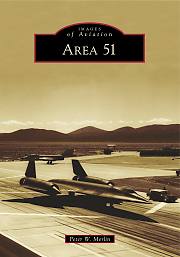 Area 51, a top secret military installation for testing unacknowledged, or black, projects, lies in a desert valley northwest of Las Vegas. During the Cold War, CIA and Air Force officials chose this remote location to shield such efforts from foreign spies and US citizens. Although the base has been known by many names--Paradise Ranch, Watertown, and Dreamland, among others--the designation "Area 51" has taken root most deeply in the public imagination. Since 1955, it has grown from a temporary camp into a national test facility supporting nearly 2,000 military and civilian workers and dozens of projects, including aircraft capable of cruising at Mach 3 and stealth airplanes that are virtually invisible to radar. Although secrecy surrounding Area 51 spawned rumors of UFOs and reverse-engineered alien spacecraft, declassified photographs provide a rare glimpse into the true nature of America's most famous secret base.
Area 51, a top secret military installation for testing unacknowledged, or black, projects, lies in a desert valley northwest of Las Vegas. During the Cold War, CIA and Air Force officials chose this remote location to shield such efforts from foreign spies and US citizens. Although the base has been known by many names--Paradise Ranch, Watertown, and Dreamland, among others--the designation "Area 51" has taken root most deeply in the public imagination. Since 1955, it has grown from a temporary camp into a national test facility supporting nearly 2,000 military and civilian workers and dozens of projects, including aircraft capable of cruising at Mach 3 and stealth airplanes that are virtually invisible to radar. Although secrecy surrounding Area 51 spawned rumors of UFOs and reverse-engineered alien spacecraft, declassified photographs provide a rare glimpse into the true nature of America's most famous secret base.Paperback, 128 pages, over 220 photos, released December 2011
Order this book from Amazon.com
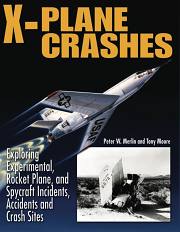 Known as "The X-Hunters," authors Peter W. Merlin and Tony Moore have located more than 100 crash sites of exotic aircraft from Edwards Air Force Base and Area 51. At these sites, they have discovered parts of supersonic rocket planes, stealthy spy craft, and vehicles that have reached the edge of space.
Known as "The X-Hunters," authors Peter W. Merlin and Tony Moore have located more than 100 crash sites of exotic aircraft from Edwards Air Force Base and Area 51. At these sites, they have discovered parts of supersonic rocket planes, stealthy spy craft, and vehicles that have reached the edge of space.
Each story in the book profiles an unusual aircraft and the brave men who flew it. The authors examine the contributing causes of each crash and use then-and-now photographs to illustrate their findings, along with many historic photos that have rarely, if ever, been seen by the general public. Each story ends with the X-Hunters' search for the crash site and what they discovered. These adventures combine C.S.I.-type skills and X-Files persistence, with a dash of Indiana Jones adventure. Specialty Press, 2008.
Order this book from Amazon.com
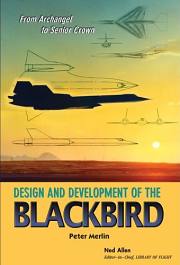 The Lockheed Blackbirds hold a unique place in the development of aeronautics. In their day, the A-12, YF-12, M-21, D-21, and SR-71 variants outperformed all other jet airplanes in terms of altitude and speed. Now retired, they remain the only production aircraft capable of sustained Mach 3 cruise and operational altitudes above 80,000 feet.
The Lockheed Blackbirds hold a unique place in the development of aeronautics. In their day, the A-12, YF-12, M-21, D-21, and SR-71 variants outperformed all other jet airplanes in terms of altitude and speed. Now retired, they remain the only production aircraft capable of sustained Mach 3 cruise and operational altitudes above 80,000 feet.
This is the first book to address the technical aspects of these incredible aircraft. The author describes the design evolution of the Blackbird, from the Archangel study that produced the A-12 to the final variant - the SR-71 - under Project Senior Crown. The book includes chapters on the construction and materials challenges faced by Lockheed, performance characteristics and capabilities of the aircraft, use of several Blackbirds as research platforms, as well as technical and programmatic lessons learned.
The book is accompanied by a CD of supplementary materials including flight manuals for the A-12, YF-12A, and SR-71; reports on Archangel design studies, aircraft specifications, and Lockheed Skunk Works operations, an SR-71 User's Handbook, numerous photos, and several videos. American Institute of Aeronautics and Astronautics, 2008.
Order this book from Amazon.com
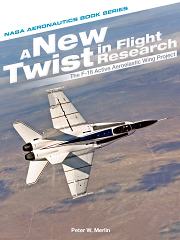 Since birds are naturally efficient flyers, it is not surprising that they have served as an inspiration to both casual observers and serious scholars of flight. In fact, lessons learned from the study of birds in centuries past may have a significant impact on future aircraft development. NASA, Air Force, and industry researchers are using wing-shaping techniques that emulate the flexibility of bird wings to develop flight controls for 21st-century airplanes. The first step toward these goals, a joint effort by NASA, Air Force, and Boeing researchers resulted in a highly modified F-18 that served as a testbed for active aeroelastic wing (AAW) technologies.
Since birds are naturally efficient flyers, it is not surprising that they have served as an inspiration to both casual observers and serious scholars of flight. In fact, lessons learned from the study of birds in centuries past may have a significant impact on future aircraft development. NASA, Air Force, and industry researchers are using wing-shaping techniques that emulate the flexibility of bird wings to develop flight controls for 21st-century airplanes. The first step toward these goals, a joint effort by NASA, Air Force, and Boeing researchers resulted in a highly modified F-18 that served as a testbed for active aeroelastic wing (AAW) technologies.
This volume describes the origins and design development of AAW technology, its application to a research aircraft, a description of the flight-test program, follow-on research and future applications. It also includes an in-depth description of program management and direction, research results and lessons learned. National Aeronautics and Space Administration, 2014.
NASA SP-2013-609. The book is available for download in a variety of formats on the NASA Web Site or via the NASA eBooks portal.
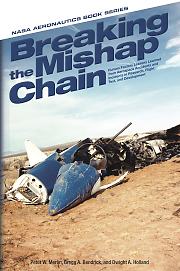 The study of human factors includes a variety of issues that affect human performance aswell as efficiency and safety. Accidents involving people, aircraft and spacecraft, though once attributed simply to “human error,” have been shown to involve not only a wide range of human factors engineering issues, but alsolayers of operational, situational and organizational factors.
The study of human factors includes a variety of issues that affect human performance aswell as efficiency and safety. Accidents involving people, aircraft and spacecraft, though once attributed simply to “human error,” have been shown to involve not only a wide range of human factors engineering issues, but alsolayers of operational, situational and organizational factors.
This volume contains a collection of case studies of mishaps involving experimental aircraft, aerospace vehicles, and spacecraft in which human factors played a significant role. In all cases the engineers involved, the leaders and managers, the operators (i.e., pilots and astronauts) were supremely qualified and by all accounts superior performers. These accidents and incidents rarely resulted from a single cause but were the outcome of a chain of events in which altering at least one element might have prevented disaster. As such, this work is offered as a learning tool so that organizations, programs, and projects of the future may not be destined to repeat the mistakes of the past. National Aeronautics and Space Administration, 2012.
NASA SP-2011-594. The book is available for download in a variety of formats on the NASA Web Site or via the NASA eBooks portal.
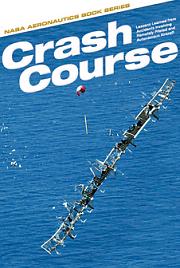 This volume contains an investigation of remotely piloted research vehicle (RPRV) and unmanned aircraft system (UAS) mishaps and will examine their causes, consequences, resultant corrective actions, and lessons learned. Most undesired outcomes usually do not occur because of a single event, but rather from a series of events and actions involving equipment malfunctions and/or human factors. This book comprises a series of case studies focusing mostly on accidents and incidents involving experimental aircraft. The information provided should be of use to flight-test organizations, aircraft operators, educators, and students, among others. These lessons are not unique to the UAS environment and are also applicable to human aviation and space flight activities. Common elements include crew resource management, training, mission planning issues, management and programmatic pressures (e.g., schedule, budget, resources), cockpit/control station design, and other factors.
This volume contains an investigation of remotely piloted research vehicle (RPRV) and unmanned aircraft system (UAS) mishaps and will examine their causes, consequences, resultant corrective actions, and lessons learned. Most undesired outcomes usually do not occur because of a single event, but rather from a series of events and actions involving equipment malfunctions and/or human factors. This book comprises a series of case studies focusing mostly on accidents and incidents involving experimental aircraft. The information provided should be of use to flight-test organizations, aircraft operators, educators, and students, among others. These lessons are not unique to the UAS environment and are also applicable to human aviation and space flight activities. Common elements include crew resource management, training, mission planning issues, management and programmatic pressures (e.g., schedule, budget, resources), cockpit/control station design, and other factors.
NASA SP-2013-600. The book is available for download in a variety of formats on the NASA Web Site or via the NASA eBooks portal.
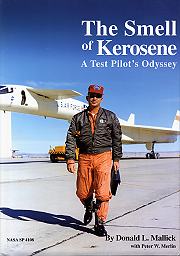 The Smell of Kerosene tells the dramatic story of a NASA research pilot who logged over 11,000 flight hours in more than 125 types of aircraft. Donald Mallick gives the reader fascinating first-hand descriptions of his early naval flight training, carrier operations, and his research flying career with NASA and its predecessor agency, the National Advisory Committee for Aeronautics (NACA).
The Smell of Kerosene tells the dramatic story of a NASA research pilot who logged over 11,000 flight hours in more than 125 types of aircraft. Donald Mallick gives the reader fascinating first-hand descriptions of his early naval flight training, carrier operations, and his research flying career with NASA and its predecessor agency, the National Advisory Committee for Aeronautics (NACA).
Mallick joined the NACA as a research pilot at the Langley Memorial Aeronautical Laboratory at Hampton, Virginia, where he flew modified helicopters and jets, and witnessed the NACA's evolution into the National Aeronautics and Space Administration.
After transferring to the NASA Flight Research Center (now NASA Dryden Flight Research Center) at Edwards, California, he became involved with projects that further pushed the boundaries of aerospace technology. These included the giant delta-winged XB-70 supersonic research airplane, the wingless M2-F1 lifting body vehicle, and the triple-sonic YF-12 Blackbird. Mallick also test flew the Lunar Landing Research Vehicle (LLRV) and helped develop techniques used in training astronauts to land on the Moon.
Fans of the Lockheed Blackbirds will not want to miss Chapter 9, a 32-page inside look at YF-12A and SR-71 flight operations from the pilot's seat.
Hardbound w/dust jacket, 252 pages, 70 B&W photos
Order this book from Amazon.com
 Mach 3+ describes the first major NASA project involving the Blackbirds. Conducted with the U.S. Air Force (USAF) as a partner, the NASA-USAF YF-12 research program lasted 10 years, and produced a wealth of data on materials, structures, loads, heating, aerodynamics, and performance for high-speed aircraft.
Mach 3+ describes the first major NASA project involving the Blackbirds. Conducted with the U.S. Air Force (USAF) as a partner, the NASA-USAF YF-12 research program lasted 10 years, and produced a wealth of data on materials, structures, loads, heating, aerodynamics, and performance for high-speed aircraft.
More than two decades after the program ended, no comprehensive history of the joint program had been written. This monograph is an attempt to rectify that deficiency. Until recently, security restrictions prevented the release of some information relative to the YF-12. Since then, numerous documents have been declassified, and program participants are free to speak about previously restricted aspects of the project.
Unfortunately, some who contributed to the NASA/USAF YF-12 investigations have not outlived the blanket of security that covered their work. Those who have must reach back more than 20 years to retrieve anecdotes and historical details. In a sense, the oral history interviews in this monograph amount to a sort of salvage archeology into the fading memories of the remaining YF-12 participants.
Over the years, numerous books and articles have been written about the Blackbirds, but few give more than a brief description of the YF-12 and its role as a research aircraft. In this monograph, Merlin briefly describes the origins of the Blackbird family of aircraft and how NASA became involved with them. Each of the following chapters then describes a facet of the NASA/USAF YF-12 research program in detail.
This monograph would not have been possible without access to numerous technical reports (some recently declassified), briefings, and other source material from the NASA Dryden Historical Reference Collection, as well as the oral interviews that fleshed out the story and provided an insider's view of the project. The book is the 25th publication of the NASA Monographs in Aerospace History series. It is available from the NASA Dryden Flight Research Center, Edwards, California.
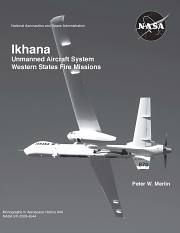 In November 2006, NASA Dryden Flight Research Center obtained a civilian version of the General Atomics MQ-9 unmanned aerial vehicle It was subsequently modified for use in research roles including Earth science missions, development of advanced aeronautical technology, and as a testbed to develop capabilities for improving the utility of unmanned aerial systems. The project team named the aircraft Ikhana, a Native American Choctaw word meaning intelligent, conscious or aware.
In November 2006, NASA Dryden Flight Research Center obtained a civilian version of the General Atomics MQ-9 unmanned aerial vehicle It was subsequently modified for use in research roles including Earth science missions, development of advanced aeronautical technology, and as a testbed to develop capabilities for improving the utility of unmanned aerial systems. The project team named the aircraft Ikhana, a Native American Choctaw word meaning intelligent, conscious or aware.
One obvious application of UAS-based remote sensing technology was in the field of emergency response to wildfires so scientist at NASA Ames Research Center equipped the aircraft with a sensor package to collect detailed infrared imagery, overlay it onto Google Earth images of local topography, and download it for use by firefighting personnel in near real-time.
This monograph describes the evolution of the Predator series of unmanned vehicles, NASA's program to develop an operational system for mapping wildfires, the Ikhana team's efforts to establish procedures for integrating unmanned vehicles into the National Air Space, and the results of several years of activity during the Western States Fire Missions. National Aeronautics and Space Administration, 2009.
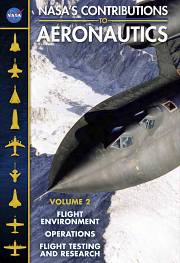 Since the mid-1990s, unmanned aerial vehicles have increasingly filled roles traditionally defined by piloted aircraft. Instead of strapping themselves into the cockpit and taking off into the unknown, test pilots more often fly remotely piloted research vehicles from the safety of a ground-based control station. Such craft are ideally suited to serve as aerodynamic and systems testbeds, airborne science platforms, and launch aircraft, or to explore unorthodox flight modes.
Since the mid-1990s, unmanned aerial vehicles have increasingly filled roles traditionally defined by piloted aircraft. Instead of strapping themselves into the cockpit and taking off into the unknown, test pilots more often fly remotely piloted research vehicles from the safety of a ground-based control station. Such craft are ideally suited to serve as aerodynamic and systems testbeds, airborne science platforms, and launch aircraft, or to explore unorthodox flight modes.
NASA scientists began exploring the Remotely Piloted research Vehicle concept at Dryden Flight Research Center in the 1960s. Since then, NASA RPRV development has contributed significantly to such technological innovations as autopilot systems, data links, and inertial navigation systems, among others. By the beginning of the 21st century, use of the once-novel RPRV concept had become standard practice.
This monograph-length essay - part of a collection in a two-volume set - describes research projects involving more than two-dozen different RPRVs from small-scale radio controlled models to a modified full-sized passenger transport. National Aeronautics and Space Administration, 2010.